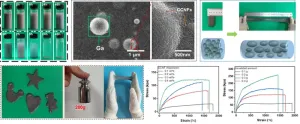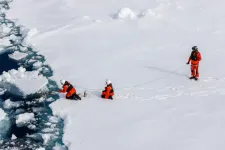(Press-News.org)
An unprecedented and continuing loss of biodiversity has been sparked by anthropogenic climate change together with the intensive use and destruction of natural ecosystems. However, since the public often views the climate crisis and the biodiversity crisis as two separate catastrophes, an international team of researchers including paleontologist Prof. Dr. Wolfgang Kiessling from Friedrich-Alexander-Universität Erlangen-Nürnberg (FAU) calls for adopting a new perspective: In their review study just released in the journal “Science”, they recommend protecting and restoring at least 30 percent of all land, freshwater and marine zones, establishing a network of interconnected protected areas, and promoting interdisciplinary collaboration between institutions.
Human beings have massively changed the Earth’s climate system by producing greenhouse gas emissions that caused the global mean temperature to rise by more than 1.1 degrees Celsius compared to the preindustrial era. The consequences for our planet are manifold and include among others the rising of global sea levels, frequent extreme weather events, and a loss in biodiversity.
Climate and biodiversity go hand in hand
In their newly published report, “Overcoming the coupled climate and biodiversity crises and their societal impacts”, 18 international researchers highlight the connection between climate crisis and biodiversity loss. Prof. Dr. Wolfgang Kiessling, FAU paleontologist and Chair of Palaeoenvironmental Research at Geozentrum Nordbayern, is one of the co-authors. He explains: “The drastic change in temperatures we experience right now has a great impact on the habitats of animate beings. Since they all have their specific range of tolerance, organisms are forced to shift their territory due to climate change. This comes with different challenges. For instance, mobile species can only migrate to cooler environments for so long until they hit a dead end, for example the coast of a landmass. Sessile organisms like coral reefs on the other hand take several generations to change their habitat. If you look at it long-term, for many of them it may already be too late.”
What makes matters worse is the loss of ecosystems due to agriculture, fishing and industry. The study’s authors estimate that human activities have altered roughly 75 percent of the land surface and 66 percent of the marine waters on our planet. As a result, today approximately 80 percent of the biomass from mammals and 50 percent of plant biomass have been lost, while more species are in danger of extinction than at any time in human history.
Coming full circle, global warming and the destruction of natural habitats not only lead to biodiversity loss, but also reduce the capacity of organisms, soils and sediments to store carbon, which in turn exacerbates the climate crisis.
Adapting now for a good future
In order to address these multiple crises, the researchers propose a combination of emissions reduction, restoration and protection measures, intelligent land-use management, and promoting cross-institutional competencies among political actors. “The key to a good future must be to not only focus on reducing emissions but to make sustainable adaptions to the already existing change in our climate, especially through nature-based solutions”, says Kiessling.
This includes the protection of coastlines by maintaining coral reefs and wetlands; the restoration of at least 30 percent of land, freshwater and marine zones to prevent further biodiversity losses; and the connection of protected areas via migration corridors, hence creating a web of safe habitats around the world for animals. The paper further emphasizes that agriculture and fishing must focus on sustainability: Resource-conserving forms of use and a reliable food supply for the human race have to be ensured, with concepts leading to intensified carbon dioxide uptake and carbon fixation in biomass and soils being prioritized. In addition, sufficient havens must be created for species responsible for making harvests possible, e.g. the insects that pollinate fruit trees.
Unanimous approach necessary
For all of these measures to be successful, countries and institutions across the world need to stand on common ground. As Kiessling puts it: “No matter the issue, be it economic, political or social, we all must look at it with climate change, biodiversity and sustainability in mind, and most importantly: We must understand that what impacts one country will definitely have an effect on others. This is why we need joint strategies and regular exchange between institutions and world leaders.”
The full report is available via the DOI: 10.1126/science.abl4881
END
This study is led by Dr. Wenxia Liu (State Key Laboratory of Biobased Materials and Green Papermaking, Qilu University of Technology, Shandong Academy of Science). To uniformly disperse LM into hydrogel, she conceived and designed using CCNFs rich in quaternary ammonium groups to encapsulate LM droplets through an approach of Pickering emulsion. “The strong electrostatic attraction and ion-dipole interaction between the quaternary ammonium groups of CCNFs and the hydroxyl groups on LM droplet surfaces were expected to prevent the LM droplets from aggregation and coalescence. The incorporation of CCNFs into hydrogel with the LM droplets was also expected to improve the mechanical ...
Recently-published research from an international team of physicists reveals how the three-dimensional shape of rigid microscopic filaments determines their dynamics when suspended in water, and how control of that shape can be used to engineer solid-like behavior even when the suspension is more than 99% water.
The paper, “Bonded straight and helical flagellar filaments form ultra-low-density glasses,” was co-authored by Georgetown physics professors Peter Olmsted and Jeffrey Urbach and graduate student Matthew ...
The alga Melosira arctica, which grows under Arctic sea ice, contains ten times as many microplastic particles as the surrounding seawater. This concentration at the base of the food web poses a threat to creatures that feed on the algae at the sea surface. Clumps of dead algae also transport the plastic with its pollutants particularly quickly into the deep sea - and can thus explain the high microplastic concentrations in the sediment there. Researchers led by the Alfred Wegener Institute have now reported this in the journal Environmental Science and Technology.
It is a food lift for bottom-dwelling animals in the deep sea: the alga Melosira arctica grows ...
The genomes of two hornet species, the European hornet and the Asian hornet (or yellow-legged hornet) have been sequenced for the first time by a team led by UCL (University College London) scientists.
By comparing these decoded genomes with that of the giant northern hornet, which has recently been sequenced by another team, the researchers have revealed clues suggesting why hornets have been so successful as invasive species across the globe.
Hornets are the largest of the social wasps; they play important ...
Running is one of the most accessible forms of exercise with an array of proven cardiovascular and musculoskeletal benefits, and an added bonus of increased mental health. Good quality running gear, such as the right pair of shoes, is vital to improve running performance and reduce injury risk. For women particularly, a well-designed sports bra protects from exercise-induced breast pain, which can be a significant barrier to practicing sports. Up to 72% of women experience breast pain while running.
Previous research has shown that the increased ...
SAN ANTONIO – 4.20.23 -Scientists from Southwest Research Institute (SwRI) led a team in the unique Citizen Continental-America Telescopic Eclipse (CATE) experiment to image the Sun’s outer atmosphere, the corona, during a short solar eclipse on the opposite side of the Earth. Using four platforms in the northwest corner of Australia, the team successfully observed the million-degree solar corona at the April 20 eclipse viewed from the Exmouth peninsula. The Australian eclipse serves both as a unique scientific opportunity and a training exercise for the program’s leadership in preparation ...
Staff in public and private hospitals in Mexico City are likely to follow well-established and reinforced earthquake early warning (EEW) protocols for evacuation, according to an ongoing study.
Overall, staff are likely to follow the protocols especially when they are “reinforced with drills that help practice the correct protective action,” said Sandra Vaiciulyte of Universidad Nacional Autónoma de México. She discussed her research at the Seismological Society of America (SSA)’s 2023 Annual Meeting.
In the study, there have been “no accounts of injuries of patients and staff because of the particular reaction by staff,” ...
Concern about the mental health of hospital professionals has been increasing in recent years, and when, in early 2020, the Covid-19 pandemic was declared and rapidly spread, there was a large increase in the overload of workers in Intensive Care Units (ICUs). Given this, researchers from the D’Or Institute for Research and Education (IDOR) and other national institutions assessed the prevalence and extent of psychological disorders such as burnout, anxiety, depression, and post-traumatic stress disorder ...
Faults in the Ridgecrest, California area were very sensitive to solid earth tidal stresses in the year and a half before the July 2019 Ridgecrest earthquake sequence, researchers reported at the Seismological Society of America (SSA)’s 2023 Annual Meeting.
“The signal of tidal modulation becomes extremely strong” after 2018, said Eric Beauce of Lamont-Doherty Earth Observatory, who noted that the signal was identified with seismicity that occurred around the faults that broke in the 2019 magnitude 7.1 earthquake.
The link ...
A new study published in Diabetologia (the journal of the European Association for the Study of Diabetes [EASD])finds that individuals who experienced childhood adversity are at increased risk of developing type 2 diabetes (T2D) in early adulthood.
The research was conducted by Assistant Professor Leonie K. Elsenburg and colleagues at the Section of Epidemiology, Department of Public Health, University of Copenhagen, Copenhagen, Denmark and aimed to determine whether there was a link between childhood adversity and the development ...



